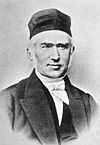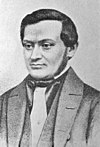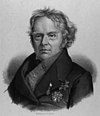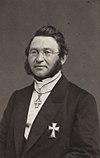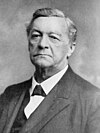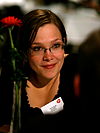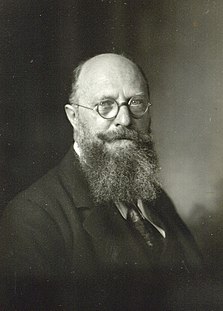List of Interior Ministers (1848–present)
Interior ministers under Frederick VII (1848–1863)
| № | Minister of the Interior | Took office | Left office | Time in office | Party | Cabinet | |
|---|---|---|---|---|---|---|---|
| 1 | Peter Georg Bang (1797–1861) | 16 November 1848 | 21 September 1849 | 309 days | Independent | Moltke I Moltke II | |
| 2 | Mathias Hans Rosenørn (1814–1902) | 21 September 1849 | 13 July 1851 | 1 year, 295 days | Independent | Moltke II | |
| 3 | Frederik Ferdinand von Tillisch (1801–1889) | 13 July 1851 | 27 January 1852 | 198 days | Independent | Moltke IV | |
| (1) | Peter Georg Bang (1797–1861) | 27 January 1852 | 21 April 1853 | 1 year, 84 days | Independent | Bluhme I | |
| 4 | Anders Sandøe Ørsted (1778–1860) | 21 April 1853 | 29 April 1854 | 1 year, 8 days | Independent | Ørsted | |
| (3) | Frederik Ferdinand von Tillisch (1801–1889) | 29 April 1854 | 12 December 1854 | 227 days | Independent | Ørsted | |
| (1) | Peter Georg Bang (1797–1861) | 12 December 1854 | 18 February 1856 | 4 years, 68 days | Independent | Bang | |
| 5 | Carl Frederik Simony (1806–1872) | 18 February 1856 | 4 June 1856 | 107 days | National Liberal | Bang | |
| 6 | Iver Johannes Unsgaard (1798–1872) | 4 June 1856 | 18 October 1856 | 136 days | Independent | Bang | |
| 7 | Andreas Frederik Krieger (1817–1893) | 18 October 1856 | 1 August 1858 | 1 year, 287 days | National Liberal | Andræ Hall I | |
| (6) | Iver Johannes Unsgaard (1798–1872) | 1 August 1858 | 6 May 1859 | 278 days | Independent | Hall I | |
| (7) | Andreas Frederik Krieger (1817–1893) | 6 May 1859 | 2 December 1859 | 210 days | National Liberal | Hall I | |
| 8 | Johan Christian von Jessen (1817–1884) | 2 December 1859 | 24 February 1860 | 84 days | National Liberal | Rotwitt | |
| 9 | Ditlev Gothard Monrad (1811–1887) | 24 February 1860 | 15 September 1861 | 1 year, 172 days | National Liberal | Hall II | |
| 10 | Peter Martin Orla Lehmann (1810–1870) | 15 September 1861 | 31 December 1863 | 2 years, 138 days | Bondevennerne | Hall II |
Interior ministers under Christian IX (1863–1906)
| № | Minister of the Interior | Took office | Left office | Time in office | Party | Cabinet | |
|---|---|---|---|---|---|---|---|
| 11 | Carl von Nutzhorn (1828–1899) | 31 December 1863 | 10 May 1864 | 131 days | Independent | Monrad | |
| 12 | Hans Rasmussen Carlsen (1810–1887) | 10 May 1864 | 11 July 1864 | 62 days | Independent | Monrad | |
| (3) | Frederik Ferdinand von Tillisch (1801–1889) | 11 July 1864 | 6 November 1865 | 1 year, 118 days | Independent | Bluhme II | |
| 13 | Jacob Brønnum Scavenius Estrup (1825–1913) | 6 November 1865 | 22 September 1869 | 3 years, 320 days | National Landowners | Frijs | |
| 14 | Wolfgang von Haffner (1810–1887) | 22 September 1869 | 28 May 1870 | 248 days | National Landowners | Frijs | |
| 15 | Christen Andreas Fonnesbech (1817–1880) | 28 May 1870 | 14 July 1874 | 4 years, 47 days | National Landowners | Holstein-Holsteinborg | |
| 16 | Fritz Tobiesen (1829–1908) | 14 July 1874 | 11 June 1875 | 332 days | Independent | Fonnesbech | |
| 17 | Erik Skeel (1818–1884) | 11 June 1875 | 29 August 1884 | 9 years, 79 days | Højre | Estrup | |
| 18 | Hilmar Finsen (1824–1886) | 29 August 1884 | 8 August 1885 | 344 days | Højre | Estrup | |
| 19 | Hans Peter Ingerslev (1831–1896) | 8 August 1885 | 15 January 1894 | 8 years, 160 days | Højre | Estrup | |
| 20 | Hugo Egmont Hørring (1842–1909) | 15 January 1894 | 23 May 1897 | 3 years, 128 days | Højre | Reedtz-Thott | |
| 21 | Vilhelm Bardenfleth (1850–1933) | 23 May 1897 | 28 August 1899 | 2 years, 97 days | Højre | Hørring | |
| 22 | Ludvig Ernst Bramsen (1847–1914) | 28 August 1899 | 24 July 1901 | 1 year, 330 days | Højre | Sehested | |
| 23 | Enevold Sørensen (1850–1920) | 24 July 1901 | 14 January 1905 | 6 years, 174 days | Venstre Reform | Deuntzer | |
| 24 | Sigurd Berg (1868–1921) | 14 January 1905 | 12 October 1908 | 6 years, 174 days | Venstre Reform | Christensen |
Interior ministers under Frederik VIII (1906–1912)
| № | Minister of the Interior | Took office | Left office | Time in office | Party | Cabinet | |
|---|---|---|---|---|---|---|---|
| 25 | Klaus Berntsen (1866–1946) | 12 October 1908 | 28 October 1909 | 1 year, 16 days | Venstre Reform | Holstein-Ledreborg | |
| 26 | Peter Rochegune Munch (1870–1948) | 28 October 1909 | 5 July 1910 | 250 days | Social Liberals | Zahle I | |
| 27 | Jens Jensen-Sønderup (1862–1949) | 5 July 1910 | 21 June 1913 | 2 years, 351 days | Venstre | Berntsen |
Interior ministers under Christian X (1912–1947)
| № | Minister of the Interior | Took office | Left office | Time in office | Party | Cabinet | |
|---|---|---|---|---|---|---|---|
| 28 | Ove Rode (1867–1933) | 21 June 1913 | 30 March 1920 | 6 years, 283 days | Social Liberals | Zahle II | |
| 29 | Waldemar Oxholm (1868–1945) | 30 March 1920 | 5 April 1920 | 6 days | Nonpartisan | Liebe | |
| 30 | Henrik Vedel (1867–1932) | 5 April 1920 | 5 May 1920 | 30 days | Nonpartisan | Friis | |
| (24) | Sigurd Berg (1868–1921) | 5 May 1920 | 11 July 1921 † | 1 year, 67 days | Venstre | Neergaard II | |
| 31 | Oluf Christian Krag (1870–1942) | 18 July 1921 | 23 April 1924 | 2 years, 287 days | Venstre | Neergaard II Neergaard III | |
| 32 | Christen Nielsen Hauge (1870–1940) | 23 April 1924 | 14 December 1926 | 2 years, 235 days | Social Democrats | Stauning I | |
| (31) | Oluf Christian Krag (1870–1942) | 14 December 1926 | 30 April 1929 | 2 years, 137 days | Nonpartisan | Madsen-Mygdal | |
| 33 | Bertel Dahlgaard (1887–1972) | 30 April 1929 | 8 July 1940 | 11 years, 69 days | Social Liberals | Stauning II–II–III–IV | |
| 34 | Knud Kristensen (1880–1962) | 8 July 1940 | 9 November 1942 | 2 years, 93 days | Venstre | Stauning VI Buhl I | |
| 35 | Jørgen Jørgensen (1888–1974) | 9 November 1942 | 29 August 1943 | 324 days | Social Liberals | Scavenius | |
| No Danish government in between 29 August 1943 and 5 May 1945. Office is assumed by the permanent secretary. | |||||||
| (34) | Knud Kristensen (1880–1962) | 5 May 1945 | 7 November 1945 | 186 days | Venstre | Buhl II | |
| 36 | Ejnar Martin Kjær (1893–1947) | 7 November 1945 | 18 June 1947 † | 1 year, 223 days | Venstre | Kristensen | |
Interior ministers under Frederik IX (1947–1972)
| № | Minister of the Interior | Took office | Left office | Time in office | Party | Cabinet | |
|---|---|---|---|---|---|---|---|
| 37 | Niels Arnth-Jensen (1883–1966) | 30 June 1947 | 13 November 1947 | 136 days | Venstre | Kristensen | |
| 38 | Alsing Emanuel Andersen (1893–1962) | 13 November 1947 | 23 November 1947 | 10 days | Social Democrats | Hedtoft I | |
| 39 | Jens Smørum (1891–1976) | 23 November 1947 | 30 October 1950 | 2 years, 341 days | Social Democrats | Hedtoft I | |
| 40 | Aksel Møller (1906–1958) | 30 October 1950 | 30 September 1953 | 2 years, 335 days | Conservative | Eriksen | |
| 41 | Johannes Kjærbøl (1885–1973) | 30 September 1953 | 30 August 1955 | 1 year, 334 days | Social Democrats | Hedtoft II Hansen I | |
| 42 | Carl Petersen (1894–1984) | 30 August 1955 | 28 May 1957 | 1 year, 271 days | Social Democrats | Hansen I | |
| 43 | Søren Olesen (1891–1973) | 28 May 1957 | 18 November 1960 | 3 years, 174 days | Justice | Hansen II Kampmann I | |
| 44 | Hans Rynkeby Knudsen (1903–1962) | 18 November 1960 | 7 September 1961 | 293 days | Venstre | Kampmann II | |
| 45 | Lars P. Jensen (1909–1986) | 7 September 1961 | 26 September 1964 | 3 years, 19 days | Social Democrats | Kampmann II Krag I | |
| 46 | Hans Erling Hækkerup (1907–1974) | 26 September 1964 | 2 February 1968 | 3 years, 129 days | Social Democrats | Krag II | |
| 47 | Poul Clorius Sørensen (1904–1969) | 2 February 1968 | 29 June 1969 † | 1 year, 147 days | Conservative | Baunsgaard | |
| 48 | Hans Carl Toft (1914–2001) | 11 July 1969 | 11 October 1971 | 2 years, 92 days | Conservative | Baunsgaard | |
| 49 | Egon Jensen (1922–1985) | 11 October 1971 | 19 December 1973 | 2 years, 69 days | Social Democrats | Krag III Jørgensen I |
Interior ministers under Margrethe II (1972–present)
| № | Portrait | Name (Born-Died) | Term | Political Party | Government | ||
|---|---|---|---|---|---|---|---|
| Took office | Left office | Duration | |||||
| Minister of the Interior (Indenrigsminister) | |||||||
| 50 | Jacob Sørensen (politician) (1915–1990) | 19 December 1973 | 13 February 1975 | 1 year, 56 days | Venstre | Hartling | |
| (49) | Egon Jensen (1922–1985) | 13 February 1975 | 30 August 1978 | 3 years, 198 days | Social Democrats | Jørgensen II | |
| 51 | Knud Enggaard (born 1929) | 30 August 1978 | 26 October 1979 | 1 year, 57 days | Venstre | Jørgensen III | |
| 52 | Henning Rasmussen (1926–1997) | 26 October 1979 | 10 September 1982 | 2 years, 319 days | Social Democrats | Jørgensen IV | |
| 53 | Britta Caroc Schall Holberg (born 1941) | 10 September 1982 | 12 March 1986 | 3 years, 183 days | Venstre | Schlüter I | |
| (51) | Knud Enggaard (born 1929) | 12 March 1986 | 10 September 1987 | 1 year, 182 days | Conservative | Schlüter I | |
| 54 | Thor Pedersen (born 1945) | 10 September 1987 | 25 January 1993 | 5 years, 137 days | Venstre | Schlüter II–II–III | |
| 55 | Birte Weiss (born 1941) | 25 January 1993 | 20 October 1997 | 4 years, 268 days | Social Democrats | P.N. Rasmussen I–II–III | |
| 56 | Thorkild Simonsen (born 1926) | 20 October 1997 | 23 February 2000 | 2 years, 126 days | Social Democrats | P.N. Rasmussen III–II | |
| 57 | Karen Jespersen (born 1947) | 23 February 2000 | 27 November 2001 | 1 year, 277 days | Social Democrats | P.N. Rasmussen IV | |
| Minister of the Interior and Health (Indenrigs- og sundhedsminister) | |||||||
| 58 | Lars Løkke Rasmussen (born 1964) | 27 November 2001 | 23 November 2007 | 5 years, 361 days | Venstre | A.F. Rasmussen I–II | |
| Dismantled, role placed within the Ministry of Social Affairs | |||||||
| - | Karen Jespersen (born 1947) | 23 November 2007 | 7 April 2009 | 1 year, 135 days | Venstre | A.F. Rasmussen III | |
| Ministry of the Interior and Social Affairs (Indenrigs- og Socialminister) | |||||||
| 59 | Karen Ellemann (born 1969) | 7 April 2009 | 23 February 2010 | 322 days | Venstre | L.L. Rasmussen I | |
| Minister of the Interior and Health (Indenrigs- og sundhedsminister) | |||||||
| 60 | Bertel Haarder (born 1944) | 23 February 2010 | 3 October 2011 | 1 year, 222 days | Venstre | L.L. Rasmussen I | |
| Ministry of Economy and the Interior (Økonomi- og Indenrigsministeriet) | |||||||
| 61 | Margrethe Vestager (born 1968) | 3 October 2011 | 2 September 2014 | 2 years, 334 days | Social Liberals | Thorning-Schmidt I–II | |
| 62 | Morten Østergaard (born 1976) | 2 September 2014 | 28 June 2015 | 299 days | Social Liberals | Thorning-Schmidt II | |
| Ministry of Social Affairs and the Interior (Social- og Indenrigsministeriet) | |||||||
| (59) | Karen Ellemann (born 1969) | 28 June 2015 | 28 November 2016 | 1 year, 153 days | Venstre | L.L. Rasmussen II | |
| Ministry of Economy and the Interior (Økonomi- og Indenrigsministeriet) | |||||||
| 63 | Simon Emil Ammitzbøll-Bille (born 1977) | 28 November 2016 | Incumbent | 2 years, 253 days | Liberal Alliance | L.L. Rasmussen III | |
| Minister for Social Affairs and the Interior (Social- og indenrigsminister) | |||||||
| 63 | Astrid Krag (born 1982) | 27 June 2019 | Incumbent | 42 days | Social Democrats | Frederiksen | |
